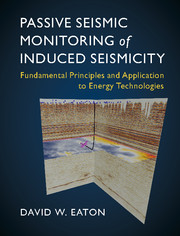 Passive Seismic Monitoring of Induced Seismicity
Passive Seismic Monitoring of Induced Seismicity Published online by Cambridge University Press: 07 June 2018
Passive seismic monitoring of induced seismicity is a highly interdisciplinary field, combining aspects of seismology, continuum mechanics, fracture mechanics, geomechanics, structural geology, reservoir engineering and many other disciplines. Consequently, unfamiliar terminology can be a significant barrier to understanding. This glossary provides a concise explanation for some of the terms used in this book.
Acoustic medium: A medium in which shear waves are not considered or do not propagate, such as liquids or gases (Sheriff, 1991). Imaging methods used in exploration seismology commonly invoke an acoustic approximation and thus consider only P -wave propagation.
Aftershock: Earthquakes that follow the largest shock of an earthquake sequence. They are smaller than the mainshock and located within 1–2 rupture lengths distance from the mainshock. Aftershocks can continue over a period of weeks, months or years. In general, the larger the mainshock, the larger and more numerous the aftershocks, and the longer they will continue (USGS, 2017).
Anisotropy: Variation of one or more physical properties of a homogeneous material with the direction of measurement (Winterstein, 1990). A common form is transverse isotropy (TI), which is characteristic of shale, thinly bedded media and media with a single set of cracks; TI media have an infinite-fold axis of rotation (symmetry axis) and an infinite set of twofold axes of rotation in the perpendicular plane. The symmetry axis may be vertical (VTI), horizontal (HTI) or tilted (TTI). Another common form is orthorhombic, which has three mutually perpendicular symmetry axes and can arise from two sets of cracks, or a single set of vertical cracks in a layered medium (Figure 1.7). TI media are described by five independent elastic parameters, while orthorhombic media require nine independent parameters.
Anomalous seismicity: Seismicity that would not normally occur when performing an operation such as hydraulic fracturing (CAPP, 2017).
Asperity: In a literal sense, asperity means “roughness” (IRIS, 2017). An area on a fault this is stuck or locked.
b value: The slope of the magnitude-frequency distribution for the Gutenberg–Richter relation, which describes the relative size distribution of earthquakes. Most earthquake fault systems have a b value close to unity, implying that for each unit increase in magnitude there are ten times fewer earthquakes.
To save this book to your Kindle, first ensure no-reply@cambridge.org is added to your Approved Personal Document E-mail List under your Personal Document Settings on the Manage Your Content and Devices page of your Amazon account. Then enter the ‘name’ part of your Kindle email address below. Find out more about saving to your Kindle.
Note you can select to save to either the @free.kindle.com or @kindle.com variations. ‘@free.kindle.com’ emails are free but can only be saved to your device when it is connected to wi-fi. ‘@kindle.com’ emails can be delivered even when you are not connected to wi-fi, but note that service fees apply.
Find out more about the Kindle Personal Document Service.
To save content items to your account, please confirm that you agree to abide by our usage policies. If this is the first time you use this feature, you will be asked to authorise Cambridge Core to connect with your account. Find out more about saving content to Dropbox.
To save content items to your account, please confirm that you agree to abide by our usage policies. If this is the first time you use this feature, you will be asked to authorise Cambridge Core to connect with your account. Find out more about saving content to Google Drive.